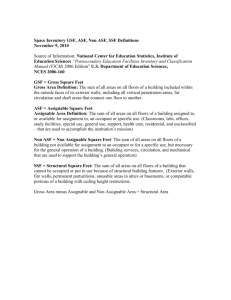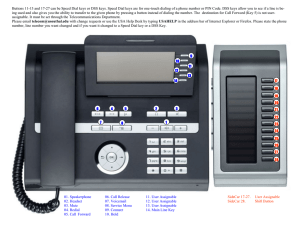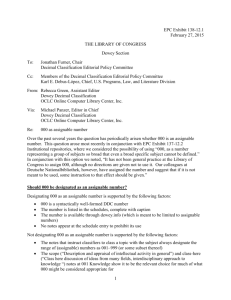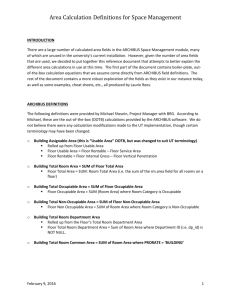CHAPTER 11 – APPENDICES APPENDIX 13 – POST SECONDARY EDUCATION FACILITIES INVENTORY
advertisement
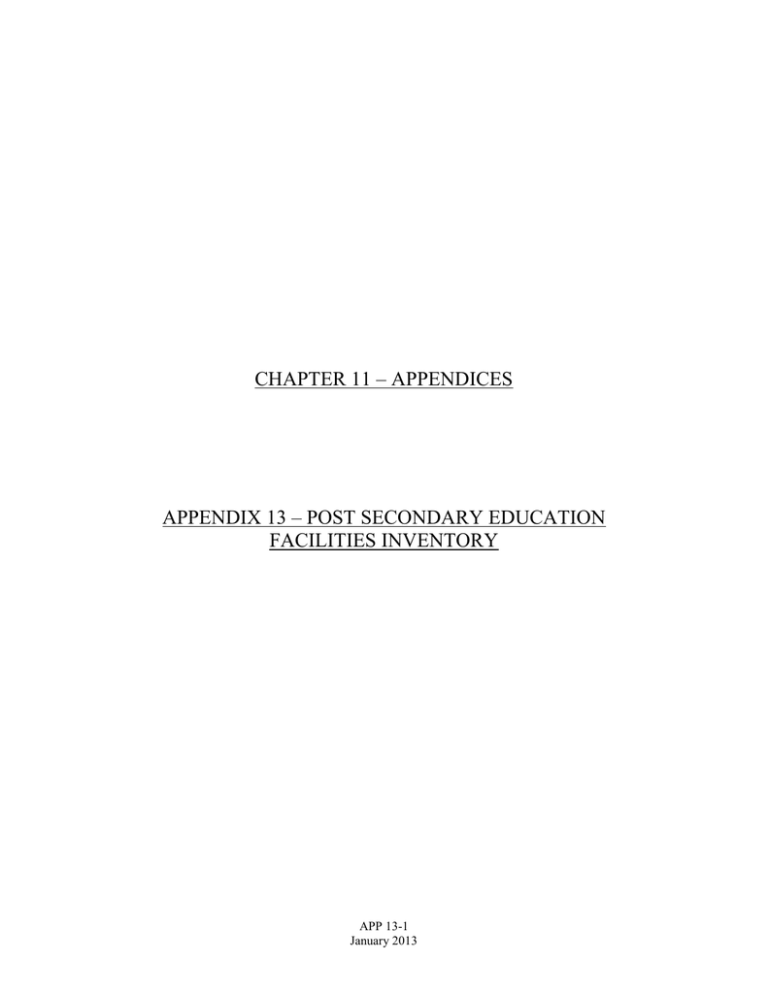
CHAPTER 11 – APPENDICES APPENDIX 13 – POST SECONDARY EDUCATION FACILITIES INVENTORY APP 13-1 January 2013 This Page Left Intentionally Blank APP 13-2 January 2013 This Page Left Intentionally Blank APP 13-3 January 2013 BUILDING DEFINITIONS AND DATA ELEMENTS This chapter provides the technical definitions, measurement procedures, and coding structures for building data elements. The interrelationships between these components of building area are illustrated by the conceptual framework in Figure 1. Definitions of Building Areas 1 The definitions and procedures provided in this chapter are intended to clarify and provide guidelines for the most commonly used types of data to be collected and compiled on buildings. These guidelines are based on the definitions and standards established during the 1960’s for the Federal Construction Council and published by the National Academy of Sciences. The Federal Construction Council standards were intended for use by federal agencies, but they have been widely adopted and used by colleges and universities. The definitions and guidelines in this chapter attempt to clarify and update some of the earlier standards by providing additional guidance on how to interpret and apply measurement procedures. The guidelines also are intended to establish a common standard for the minimum amount of data to be included in a building inventory in order to provide a database that is usable for both intra-institutional and inter-institutional purposes. Institutions are not precluded by these guidelines from collecting additional building data or from including other types of structures in their facilities inventory. 1. Gross Area A. Definition: The sum of all areas on all floors of a building included within the outside faces of its exterior walls, including floor penetration areas, however insignificant, for circulation and shaft areas that connect one floor to another. B. Basis for Measurement: Gross area is computed by physically measuring or scaling measurements from the outside faces of exterior walls, disregarding cornices, pilasters, buttresses, etc., which extend beyond the wall faces. Exclude areas having less than a six-foot, six-inch clear ceiling height unless the criteria of a separate structure are met. Measured in terms of gross square feet (GSF), Gross Area = Net Usable Area + Structural Space C. Description: In addition to all the internal floored spaces obviously covered above, gross area should include the following: excavated basement areas; mezzanines, penthouses, and attics; garages; enclosed porches, inner or outer balconies whether walled or not, if they are utilized for operational functions; and corridors whether walled or not, provided they are within the outside face lines of the building, to the extent of the roof drip line. The footprints of stairways, elevator shafts, and ducts (examples of building infrastructure) are to be counted as gross area on each floor through which they pass. D. Limitations: Exclude open areas such as parking lots, playing fields, courts, and light wells, or portions of upper floors eliminated by rooms or lobbies that rise above singlefloor ceiling height. E. Exception: Include top, unroofed floor of parking structures where parking is available. (See the section on Parking Structures at the end of this chapter.) 1 Source: Federal Construction Council Technical Report No. 50 (Publication 1235), Classification of Building Areas, National Academy of Sciences, Building Research Advisory Board. APP 13-4 January 2013 2. Assignable Area (Net Assignable Square Feet – NASF) A. Definition: The sum of all areas on all floors of a building assigned to, or available for assignment to, an occupant or specific use. B. Basis for Measurement: Assignable area is computed by physically measuring or scaling measurements from the inside faces of surfaces that form the boundaries of the designated areas. Exclude areas having less than a six-foot, six-inch clear ceiling height unless the criteria of a separate structure are met. Measured in terms of assignable square feet (ASF), Assignable Area = Sum of Area Designated by the Ten Assignable Major Room Use Categories. 3. C. Description: Included should be space subdivisions of the ten major room use categories for assignable space – classrooms, labs, offices, study facilities, special use, general use, support, health care, residential and unclassified – that are used to accomplish the institution’s mission. D. Limitations: Deductions should not be made for necessary building columns and projections. Areas defined as building service, circulation, mechanical, and structural should not be included. Nonassignable Area A. Definition: The sum of all areas on all floors of a building not available for assignment to an occupant or for specific use, but necessary for the general operation of a building. B. Basis for Measurement: Nonassignable Area is computed by physically measuring or scaling measurements form the inside faces of surfaces that form the boundaries of the designated areas. Excludes areas having less than six-foot, six-inch clear ceiling height unless the criteria of a separate structure are met. Measured in terms of area, Nonassignable Area = Sum of the Area Designated by Three Nonassignable Room Use Categories. 4. C. Description: Included should be space subdivisions of the three nonassignable room use categories – building service, circulation and mechanical – that are used to support the buildings’ general operation. D. Limitations: Deductions should not be made for necessary building columns and projections. Areas defined as assignable should not be included. Building Service Area A. Definition: The sum of all areas on all floors of a building used for custodial supplies, sink rooms, janitorial closets, and for public rest rooms. (NOTE: Building service area includes all areas previously classified as custodial area. Building service area also includes public rest rooms that were previously classified as mechanical area. Building Service Area does not include assignable areas (e.g., areas classified as 730-Central Storage and 870-Central Supplies are not part of Building Service Area). APP 13-5 January 2013 5. 6. B. Basis for Measurement: Building service area is computed by physically measuring or scaling measurements from the inside faces of surfaces that form boundaries of the designated areas. Exclude areas having less than a six-foot, six-inch clear ceiling height unless the criteria of a separate structure are met. C. Description: Included should be janitor closets or similarly small cleanup spaces, maintenance material storage areas, trashrooms exclusively devoted to the storage of nonhazardous waste created by the building occupants as a whole, and public toilets. D. Limitations: Deductions should not be made for necessary building columns and minor projections. Areas defined as central physical plant shop areas, or special purpose storage or maintenance rooms, such as linen closets and housekeeping rooms in residence halls, should not be included. Does not include private rest rooms. Circulation Area A. Definition: The sum of all areas on all floors of a building required for physical access to some subdivision of space, whether physically bounded by partitions or not. B. Basis for Measurement: Circulation area is computed by physically measuring or scaling measurements from the inside faces of surfaces that form the boundaries of the designated areas. Exclude areas having less than a six-foot, six-inch clear ceiling height unless the criteria of a separate structure are met. C. Description: Included should be, but is not limited to, public corridors, fire towers, elevator lobbies, tunnels, bridges, and each floor’s footprint of elevator shafts, escalators and stairways. Receiving areas, such as loading docks, should be treated as circulation space. Any part of a loading dock that is not covered is to be excluded from both circulation area and the gross building area. A loading dock which is also used for central storage should be regarded as assignable area and coded as central storage (730). Also included are corridors, whether walled or not, provided they are within the outside facelines of the buildings to the extent of the roof drop line. D. Limitations: Deductions should not be made for necessary building columns and minor projections. When determining corridor areas, only spaces required for public access should be included. Restricted access private circulation aisles used only for circulation within an organizational unit’s suite of rooms, auditoria, or other working areas should not be included. Mechanical Area A. Definition: The sum of all areas on all floors of a building designed to house mechanical equipment, utility services, and shaft areas. B. Basis for Measurement: Mechanical area is computed by physically measuring or scaling measurements from the inside faces of surfaces that form the boundaries of the designated areas. Exclude areas having less than six-foot, six-inch clear ceiling height unless the criteria of a separate structure are met. C. Description: Included should be mechanical areas such as central utility plants, boiler rooms, mechanical and electrical equipment rooms, fuel rooms, meter and communications closets, and each floor’s footprint of air ducts, pipe shafts, mechanical service shafts, service chutes, and stacks. D. Limitations: Deductions should not be made for necessary building columns and projections. Areas designated as private toilets are not included. APP 13-6 January 2013 7. Net Usable Area A. Definition: The sum of all areas on all floors of a building either assigned to, or available for assignment to, an occupant or specific use, or necessary for the general operation of a building. B. Basis for Measurement: Net usable area is computed by summing the assignable area and the nonassignable area. Measured in terms of net usable square feet (NUSF), Net Usable Area = Assignable Area + Nonassignable Area. 8. C. Description: Included should be space subdivisions of the ten assignable major room use categories and the three nonassignable space categories. D. Limitations: Deductions should not be made for necessary building columns and projections. Areas defined as structural should not be included. Structural Area 2 A. Definition: The sum of all areas on all floors of a building that cannot be occupied or put to use because of structural building features. B. Basis for Measurement: Precise computation by direct measurement is not possible under these definitions. It is determined by calculating the difference between the measured gross area and the measured net usable area. Measured in terms of area, Structural Area = Gross Area – Net Usable Area. C. Description: Examples of building features normally classified as structural areas include exterior walls, fire walls, permanent partitions, unusable areas in attics or basements, or comparable portions of a building with ceiling height restrictions, as well as unexcavated basement areas. Other Building Information 1. Estimated Replacement Cost A. Definition: The estimated cost to replace the building at the time of inventory. B. Basis for calculation: Determined in terms of the cost to replace the building’s gross floor area at current construction costs in accordance with current building and public safety codes, and standard construction methods. The Engineering New Record, R.S. Means 3, or Boeckh 4 are examples of frequently used sources of 2 Referred to as “construction area” in TR-50. R.S. Means Company, Inc., Construction Consultants and Publishers, publishes an historical cost index. In addition, the Commercial/Industrial/Institutional section of one of the Means’ manuals contains base building costs per square foot or floor area for seventy model buildings. 3 APP 13-7 January 2013 information for determining construction cost indices. The selected source of information should be locally determined. The replacement cost of fixed equipment in the building should be included. 2. Condition A. Definition: The physical status of the building at the time of the inventory or audit, based on the best judgment of those persons familiar with the physical characteristics and condition of the campus. B. Derivation: The most useful facilities management information is produced when the inventory or audit rates each subsystem of a building. This approach documents the building’s overall composite rating and provides information about needed repairs or replacements. A facilities audit should tie subsystem and overall composite ratings to the estimated building replacement value to provide a rough estimate of the cost of rehabilitating or renovating the facility. 5 4 The Boeckh Division of the American Appraisal Company computes a construction cost index that appears applicable to the mix and types of buildings found on college and university campuses. The index is reported in the Higher Education Price Indexes by Research Associates of Washington (Washington, D.C.) 5 For a simple approach to procedures and categories rating facility subsystems, see Kaiser, H.H., Facilities Audit Workbook: A Self-Evaluation Process for Higher Education, Alexandria, VA, 1987, Association of Physical Plant Administrators of Universities and Colleges. APP 13-8 January 2013
